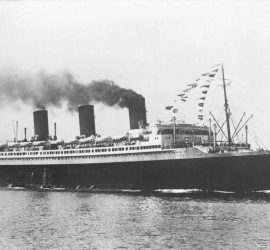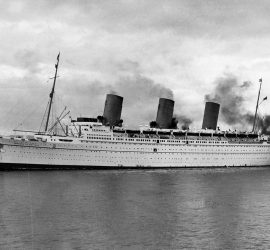1927 – 1959 / Ushering in a new era, Île de France catapulted to stardom when she introduced Art Deco on the North Atlantic in 1927. Showcasing all the best France had to offer, she was a ship of state in every sense of the word.
world war II
1927 – 1946 / An Italian ship on the South American run, the Augustus was also employed doing cruises during the hard times of the 1930s. She was converted into an aircraft carrier during World War II, but was damaged beyond repair in the conflict.
1927 – 1940 / As one of the last ships built with reciprocating engines in conjunction with an auxiliary turbine, the second Laurentic was an intermediate White Star liner built to fill gaps in the interwar years. When World War II broke out, she was refitted as an armed merchant cruiser, and in that guise she was torpedoed and sunk in 1940.
1927 – 1945 / As the largest and fastest liner on the South American run, this German liner saw great success during her early years. She remained stationary during World War II, and was tragically bombed in 1945 while packed full with prisoners transferred from concentration camps. More than 5,000 lives were lost.
1928 – 1965 / Also known as Italia / As Swedish-American Line’s second newbuild, the Kungsholm offered both crossings and cruisings up until the outbreak of World War II, when she was requisitioned and used as an American troopship. After the war, her career continued under a new name with Home Lines.
1930 – 1962 / Also known as Liberté / Also a Blue Riband champion, the Europa enjoyed a longer career than her sister Bremen. After World War II, she was handed over to the French and became the much-loved Liberté. In this guise, she sailed into the 60s.
1930 – 1966 / Also known as Empress of Scotland (II) and Hanseatic (I) / Built during the interwar years, the second Empress of Japan was the fastest and largest Pacific liner of her time. She served in both peace and war, and was then given an extensive refit and saw a second career as the Hanseatic.
1930 – 1960 / White Star modernised their fleet with the third Britannic, the first British motor ship on the North Atlantic. After trooping duties during World War II, she had a prosperous post-war career, and she is noteworthy for being the last remaining liner of the White Star Line at the time of her retirement.
1931 – 1940 / Launched as the Canadian-Pacific Line’s largest ship to date, the second Empress of Britain quickly became a popular ship for both crossings and cruises. Sadly, her career was cut short by World War II, when she was torpedoed and sunk while employed as an allied troop transport.










